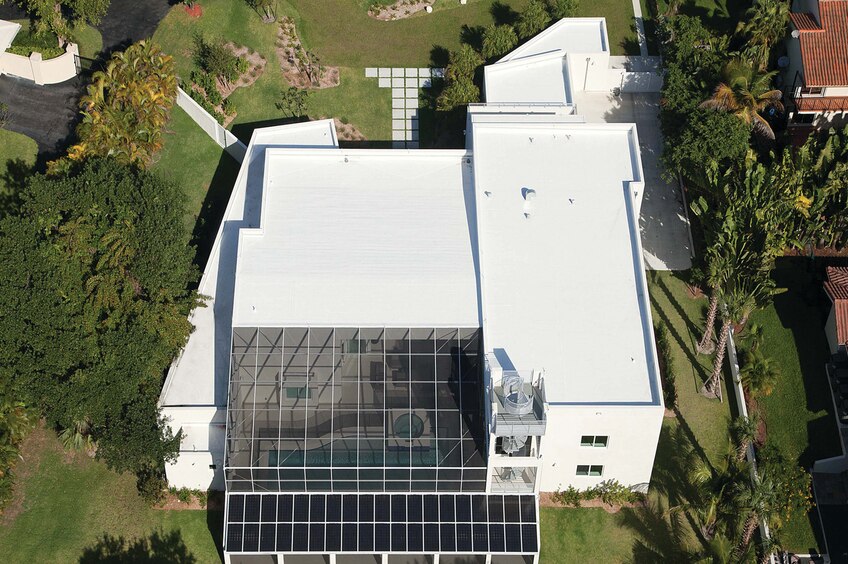For most single-ply membrane roofing projects, chemical resistance of the membrane is not a consideration. However, in a few cases, the roof can be exposed to chemicals, oils, greases and the like. In these situations, the right membrane must be chosen. If chemical resistance is required, it must be balanced against other key factors that must be satisfied in order to meet all the requirements of the specific project. Other key factors may include protection against the damaging effects of UV rays and heat, ease of installation, heat seam-ability, guarantee or warranty requirements, etc.
In general, emissions and releases of chemical materials from industrial and commercial operations are tightly regulated and should never be a concern for a building's roof. In fact, membrane specifications often do not include requirements for chemical resistance and manufacturer guarantees and warranties typically exclude from coverage leaks or other damage caused by chemical exposure. However, membrane suppliers do occasionally get asked for guidance relating to potential chemical exposure. Building owners sometimes have concerns about such things as cleaning materials, oil, grease spills from grease traps, and "fumes."
Of course, designing a roof to meet the specific needs of a building remains the responsibility of the architect, specifier, engineer, or roofing contractor of record. Nevertheless, certain membranes can withstand exposure to chemicals better than others. In all cases, however, damage due to oil, greases, or chemicals are typically excluded from coverage under manufacturer guarantees and warranties.
TPO: The "all around" membrane
TPO roofing membranes have a very good balance of properties. They provide excellent protection against the damaging effects of UV rays and heat, good seam strength and easy welding, and high overall value. Guarantees or warranties lasting as long as 35 years can be obtained for adhered longer-life TPO membranes, such as EverGuard Extreme® TPO. However, TPO may weather faster than normal when exposed to certain chemicals. It may also absorb greases and oils, causing staining. Therefore, a second "sacrificial" layer of membrane should be applied in areas around grease traps, vents, and stacks that might be exposed to chemicals.
PVC: The flexible membrane
PVC roofing membrane is more flexible than TPO and is sometimes preferred due to its ease of handling. It is more acid-resistant than TPO and is often recommended for roofs that might be exposed to grease and oils. However, greases and oils will often "draw out" the plasticizers from the sheet and cause hardening and embrittlement of the membrane.
PVC-KEE: For improved resistance
PVC-KEE is widely regarded as having excellent chemical resistance. It can withstand a broad range of chemicals and solutions, making it a better choice than other heat-weldable single-ply membranes for projects that may experience chemical exposure. However, as noted in the next section, the degree of exposure, the area of exposure, and the frequency of exposure will increase the effect on the membrane.
Project-Specific Chemical Resistance
Obviously, the degree of chemical attack on any material will be influenced by a number of factors and their interactions.
- Some combinations of chemicals may be more harmful to the membrane than the individual chemicals.
- Increasing the concentration of chemicals increases their damaging effect on the membrane.
- Higher temperatures increase the damaging effect of chemicals on the membrane.
- The degree of exposure, the area of exposure, and the frequency of exposure may increase the damaging effect on the membrane.
Conclusions
In general, roofs should not be exposed to chemicals. In fact, the first question that should be asked if a building owner has a concern about chemical exposure is how to eliminate or reduce the risk of chemical release from the building. If a roof is being exposed to chemicals, it might be a sign of broader, more serious issues.
However, leaks from grease traps, occasional releases of chemical mists, etc., can occur. Strong acids of any type, oxidizers, and most strong bases are known to cause issues with most roofing membranes regardless of type. It is important to note that the degree of attack on any material is influenced by a number of variable factors, including concentration of the chemical, temperature, aeration, duration of exposure, stability of the fluid, possible chemical reaction with other compounds in the area, etc.
The building owner's concerns should be evaluated by the architect, specifier, engineer, or roofing contractor to determine whether the project-specific conditions will be compatible with any roof membrane.

